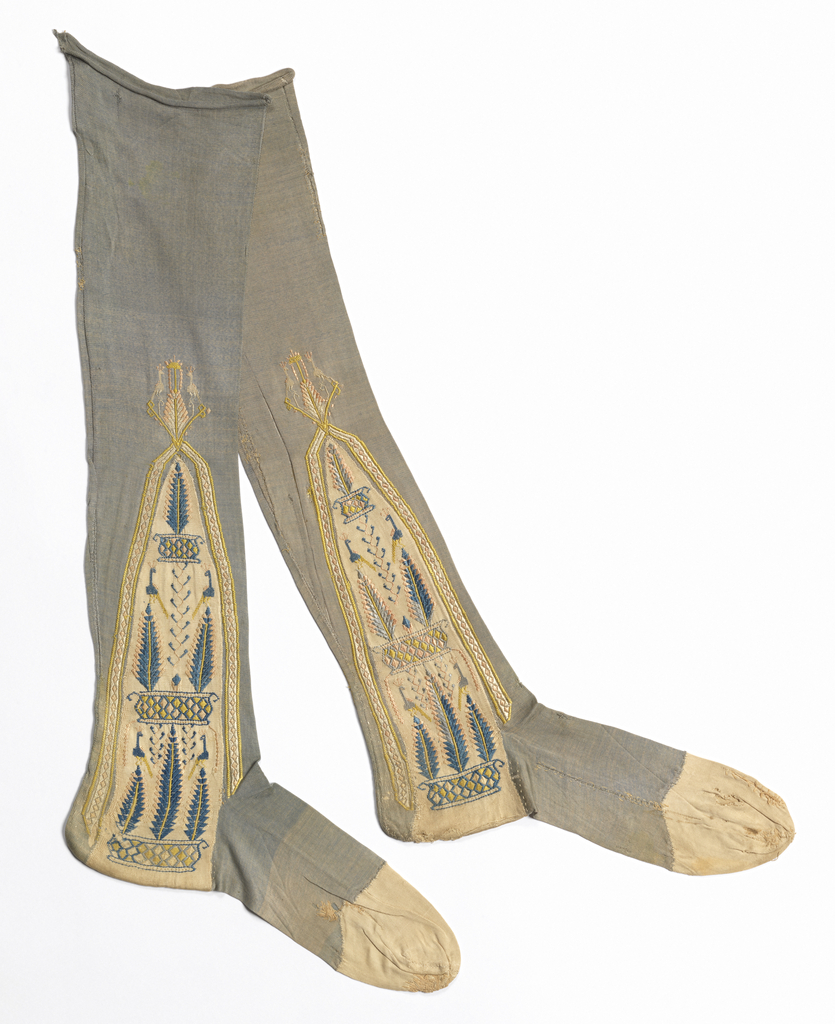Relatively little is known about this pair of men’s silk stockings. The donor of the stockings, Richard Greenleaf, identified them as being French and dating from the late eighteenth or early nineteenth century. One thing that we do know about them is that they were knitted on a machine; although we tend to associate the Industrial Revolution with technologies related to woven textiles, knitted textiles, particularly stockings, were in the vanguard of the Industrial Revolution.
People of all classes in Europe, both men and women, had worn stockings since the beginning of the Middle Ages.[i] Until the early seventeenth century, stockings were made by hand, either knitted or sewn out of pieces of woven cloth.[ii] Knitted stockings were preferred because the greater elasticity of the fabric allowed a skilled knitter to fashion a stocking that would fit the leg and foot more neatly than a stocking that was sewn. The shift in fashion in the mid-sixteenth century to short breeches that ended above the knee, a style which exposed more of a gentleman’s leg, undoubtedly contributed to the demand for high quality knitted stockings offering a smooth fit.
Fortuitously, in 1589, William Lee, an Englishman, invented a machine that could produce textiles having the same properties as the materials produced by hand knitters, although using an action that is more akin to crocheting than to knitting.[iii] While the product of his initial “stocking frame” was relatively coarse, within ten years, Lee had succeeded in increasing the number of needles per inch from eight to twenty, which allowed him to produce much finer fabric.[iv]
Lee’s invention revolutionized the production of knitted stockings in Europe. Almost immediately, they became much cheaper because of the dramatic reduction in the labor component built into the price. Working with fine yarn on thin needles, a hand-knitter could produce two pairs of stockings a week.[v] By contrast, knitting frames could work much more rapidly, producing between twenty-five and thirty pairs of stockings per week.[vi] The lower price and the increased demand set the stage for the development of what would quickly become an “industry” in the modern sense, and the use of “stocking frames” became wide-spread by the middle of the seventeenth century, more than a hundred years before the mechanization of other parts of the textile industry.
Nancy Olson is a student in the Parsons/Cooper-Hewitt Masters Program in the History of Decorative Arts and Design. She is delighted to have the opportunity to use the study of material culture as a means of gaining a deeper understanding of our collective history.
[i] John Peacock, The Chronicle of Western Costume (London: Thames & Hudson Ltd., 1991), 9-32.
[ii] Cora Ginsburg LLC, A Catalogue of exquisite & rare works of art including 16th to 20th century costume textiles & needlework, New York 2013, 21.
[iii] Walter English, The Textile Industry: An Account of the Early Inventions of Spinning, Weaving, and Knitting Machines (London and Harlow: Longmans, Green and Co. Ltd., 1969), 13-16.
[iv] Wikipedia, s.v. “Stocking frame,” accessed October 22, 2013, http://en.wikipedia.org/wiki/Stocking_frame
[v] Thirsk, op. cit.: 64.
[vi] English, op. cit.: 16-18.
